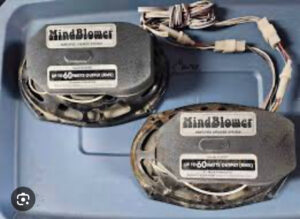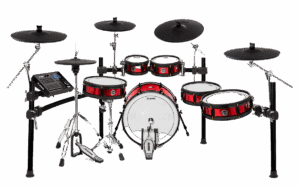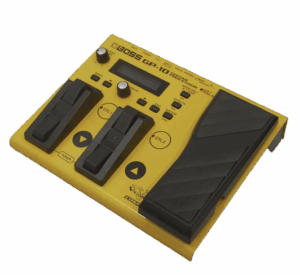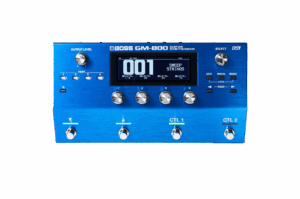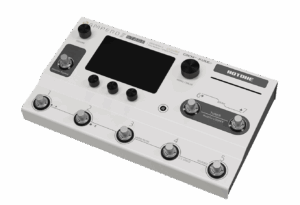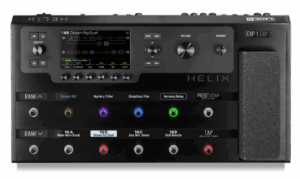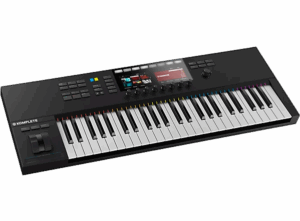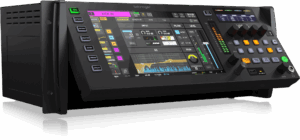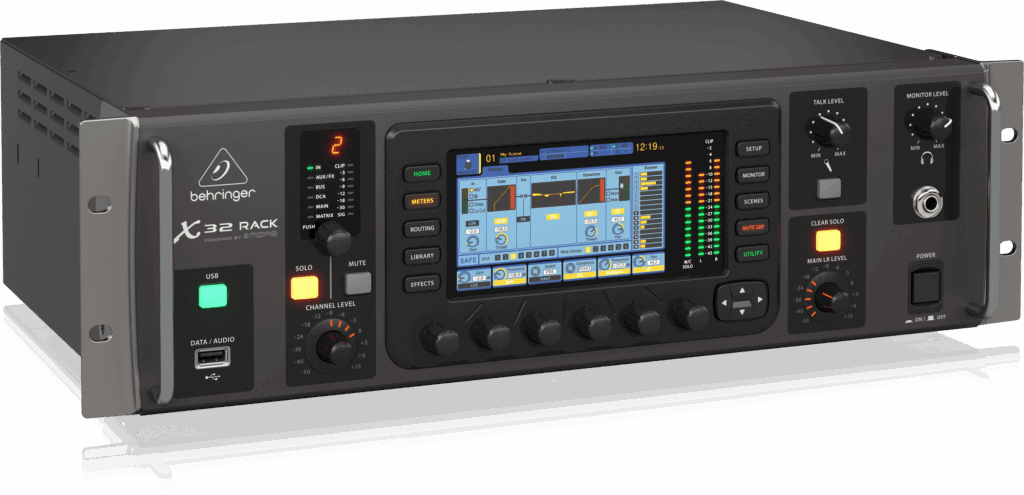
The Behringer X32 Rack is a 40-channel, 25-bus digital mixing console in a compact 3RU rackmount format, designed for live sound, studio recording, and broadcast applications. Launched as part of the X32 series, it combines affordability with professional-grade features, making it a popular choice for musicians, audio engineers, and houses of worship. Below is a detailed review based on its features, performance, and user feedback.
Behringer X32 Rack Review
- Build and Design
- Compact 3RU rackmount design, highly portable at 21 lbs (9.5 kg), ideal for small venues, mobile rigs, or installations.
- 5-inch color TFT display with responsive navigation, though some users find it small compared to larger consoles like the X32 Producer.
- Front-panel controls include 8 buttons, 4 encoders, and a jog wheel for menu navigation, but lacks faders, requiring app or external controller use for hands-on mixing.
- Rugged build with metal chassis, suitable for touring, though some report issues with rack ears bending under heavy stress.
- Drawback: No touchscreen, and the display can be hard to read in bright outdoor settings.
- Audio Quality and Preamps
- Features 16 Midas-designed mic preamps, delivering clean, transparent sound with good headroom, comparable to higher-end consoles.
- 48 kHz sample rate with 24-bit resolution, providing solid audio fidelity for live and studio use.
- Users note the preamps are “punchy” and handle high SPL well, though some detect a slight harshness in the high-mids compared to Midas PRO series.
- Headphone output can introduce noise with sensitive IEMs, a common critique across the X32 series; external headphone amps are often recommended.
- I/O and Connectivity
- 16 XLR/combo inputs, 8 XLR outputs, 6 aux in/out via TRS, and 2 AES50 ports (96 in/out channels) for expansion with stageboxes like the S16 or S32.
- Built-in 32×32 USB audio interface for direct multitrack recording to a DAW, with reliable performance on macOS and Windows (requires driver).
- Ultranet port for integration with Behringer’s P16 personal monitoring system, a favorite for IEM setups.
- Dual SD card slots for 32-track recording/playback, though limited to WAV format and lacks advanced marker features.
- Limitation: Only 8 analog outputs can be restrictive for complex IEM or monitor mixes, often requiring additional stageboxes.
- Processing and Effects
- 8 stereo effects engines with over 50 algorithms, including emulations of classic gear like Lexicon reverbs, Teletronix LA-2A, and dbx 160 compressors.
- Each of the 40 input channels includes a gate, compressor, and 4-band parametric EQ; buses (16 aux, 6 matrix, 3 main) feature 6-band parametric EQ and dynamics.
- 100 mm motorized faders are absent, but the X32-Edit app or external controllers (e.g., X-Touch) provide virtual fader control.
- RTA (Real-Time Analyzer) available but lacks overlay on EQ screens unless using third-party apps like Mixing Station.
- Drawback: Effects routing can be less intuitive, and some users report latency when using multiple effects on a single channel.
- Routing and Workflow
- Flexible routing with scribble strips (via app or display) for channel naming and color-coding, improving workflow in live settings.
- Scene and snapshot management for recalling show settings, with safe parameters to prevent unintended changes during transitions.
- Compatible with X32/M32 ecosystem, allowing seamless integration with other stageboxes and expanders for larger setups.
- X32-Edit app (PC/Mac) and X32-Mix app (iPad) enable remote mixing, though some users experience occasional Wi-Fi dropouts with the app.
- Critique: Learning curve for beginners due to menu-heavy navigation, and lack of physical faders can slow down live adjustments without an external controller.
- Value and Reliability
- Priced around $1,199, offering exceptional value for a 40-channel digital mixer with extensive I/O and effects, undercutting competitors like the PreSonus StudioLive.
- Widely praised for reliability in live settings, with many users reporting years of trouble-free operation in churches, schools, and small venues.
- Firmware updates (e.g., v4.06) have added features like improved Dante integration and bug fixes, keeping the unit relevant.
- Some concerns about long-term durability, with reports of encoder failures or display issues after 4-5 years of heavy use.
- Warranty: 1-year standard, extendable to 3 years with registration (US only).
- User Experience
- Intuitive for users familiar with digital mixers, but the lack of physical faders frustrates some who prefer tactile control.
- Mixing Station app is a popular third-party option, offering faster navigation and better RTA integration than Behringer’s native apps.
- Users appreciate the compact size for tight spaces (e.g., broadcast booths, small stages), but note the need for additional hardware (e.g., stageboxes, controllers) for larger setups.
- Common praise: “Best bang for the buck” for small to mid-sized venues, with features rivaling mixers costing twice as much.
- Common critique: Limited analog outputs and occasional app connectivity issues can hinder complex workflows.
Summary
The Behringer X32 Rack is a versatile, budget-friendly digital mixer that punches above its weight for live sound, studio recording, and installations. Its 16 Midas preamps, 32×32 USB interface, and 8 stereo effects engines make it a powerhouse for small to mid-sized applications, while its compact 3RU design ensures portability. The extensive routing options, scene management, and compatibility with the X32 ecosystem add to its appeal. However, the lack of physical faders, limited analog outputs, and occasional app connectivity issues may require workarounds, such as external controllers or stageboxes. Overall, the X32 Rack remains a top choice for budget-conscious audio professionals, delivering professional-grade performance at an unbeatable price.
- Back Home : R.T. 3 Music Equipment Review
